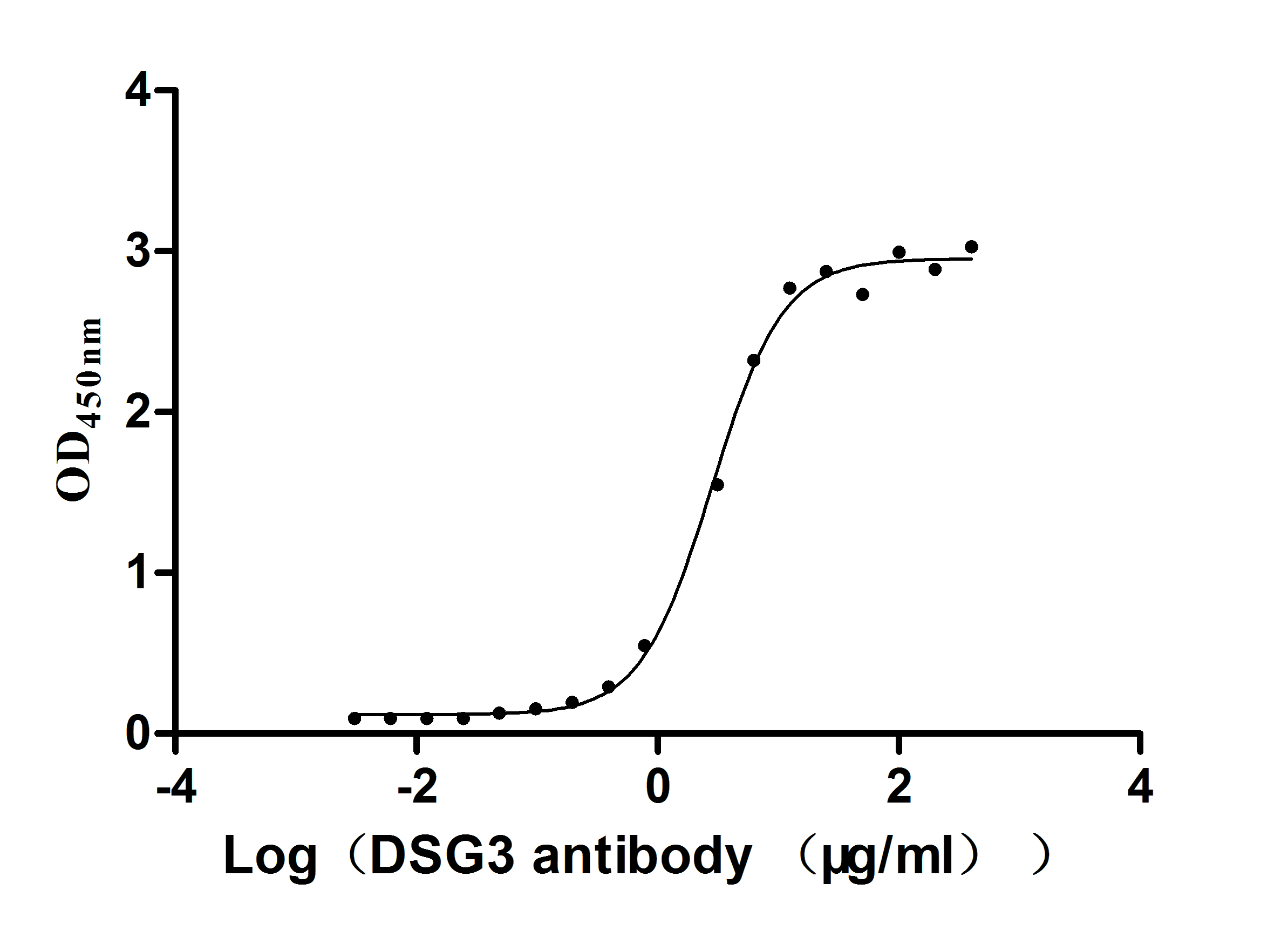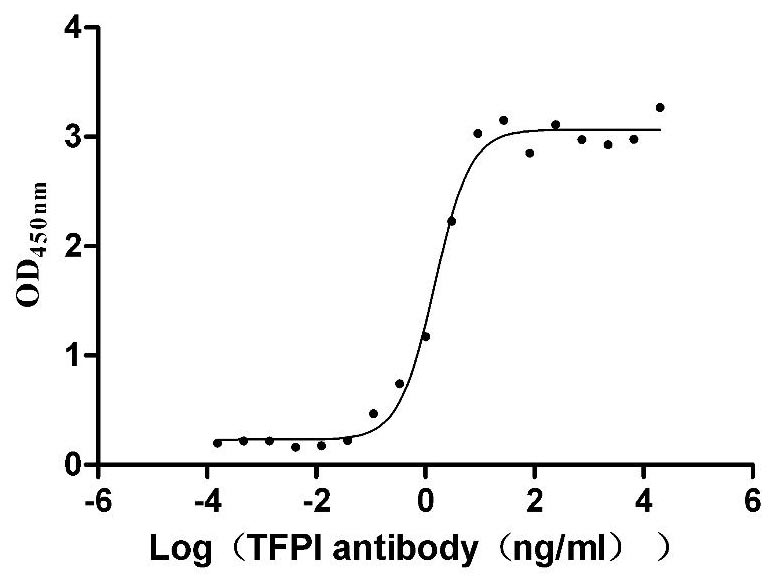Recombinant Human Gasdermin-B (GSDMB)
-
货号:CSB-YP823445HU
-
规格:
-
来源:Yeast
-
其他:
-
货号:CSB-EP823445HU-B
-
规格:
-
来源:E.coli
-
共轭:Avi-tag Biotinylated
E. coli biotin ligase (BirA) is highly specific in covalently attaching biotin to the 15 amino acid AviTag peptide. This recombinant protein was biotinylated in vivo by AviTag-BirA technology, which method is BriA catalyzes amide linkage between the biotin and the specific lysine of the AviTag.
-
其他:
-
货号:CSB-BP823445HU
-
规格:
-
来源:Baculovirus
-
其他:
-
货号:CSB-MP823445HU
-
规格:
-
来源:Mammalian cell
-
其他:
产品详情
-
纯度:>85% (SDS-PAGE)
-
基因名:GSDMB
-
Uniprot No.:
-
别名:123; 156; Gasdermin B; Gasdermin like protein; Gasdermin-B; Gasdermin-like protein; GSDMB; GSDMB_HUMAN; GSDML; PP4052; PRO2521
-
种属:Homo sapiens (Human)
-
蛋白长度:full length protein
-
表达区域:1-411
-
氨基酸序列MFSVFEEITR IVVKEMDAGG DMIAVRSLVD ADRFRCFHLV GEKRTFFGCR HYTTGLTLMD ILDTDGDKWL DELDSGLQGQ KAEFQILDNV DSTGELIVRL PKEITISGSF QGFHHQKIKI SENRISQQYL ATLENRKLKR ELPFSFRSIN TRENLYLVTE TLETVKEETL KSDRQYKFWS QISQGHLSYK HKGQREVTIP PNRVLSYRVK QLVFPNKETM SAGLDIHFRG KTKSFPEGKS LGSEDSRNMK EKLEDMESVL KDLTEEKRKD VLNSLAKCLG KEDIRQDLEQ RVSEVLISGE LHMEDPDKPL LSSLFNAAGV LVEARAKAIL DFLDALLELS EEQQFVAEAL EKGTLPLLKD QVKSVMEQNW DELASSPPDM DYDPEARILC ALYVVVSILL ELAEGPTSVS S
-
蛋白标签:Tag type will be determined during the manufacturing process.
The tag type will be determined during production process. If you have specified tag type, please tell us and we will develop the specified tag preferentially. -
产品提供形式:Lyophilized powder
Note: We will preferentially ship the format that we have in stock, however, if you have any special requirement for the format, please remark your requirement when placing the order, we will prepare according to your demand. -
复溶:We recommend that this vial be briefly centrifuged prior to opening to bring the contents to the bottom. Please reconstitute protein in deionized sterile water to a concentration of 0.1-1.0 mg/mL.We recommend to add 5-50% of glycerol (final concentration) and aliquot for long-term storage at -20℃/-80℃. Our default final concentration of glycerol is 50%. Customers could use it as reference.
-
储存条件:Store at -20°C/-80°C upon receipt, aliquoting is necessary for mutiple use. Avoid repeated freeze-thaw cycles.
-
保质期:The shelf life is related to many factors, storage state, buffer ingredients, storage temperature and the stability of the protein itself.
Generally, the shelf life of liquid form is 6 months at -20°C/-80°C. The shelf life of lyophilized form is 12 months at -20°C/-80°C. -
货期:Delivery time may differ from different purchasing way or location, please kindly consult your local distributors for specific delivery time.Note: All of our proteins are default shipped with normal blue ice packs, if you request to ship with dry ice, please communicate with us in advance and extra fees will be charged.
-
注意事项:Repeated freezing and thawing is not recommended. Store working aliquots at 4°C for up to one week.
-
Datasheet :Please contact us to get it.
相关产品
靶点详情
-
功能:Precursor of a pore-forming protein that acts as a downstream mediator of granzyme-mediated cell death. This form constitutes the precursor of the pore-forming protein: upon cleavage, the released N-terminal moiety (Gasdermin-B, N-terminal) binds to membranes and forms pores, triggering pyroptosis.; Pore-forming protein produced by cleavage by granzyme A (GZMA), which causes membrane permeabilization and pyroptosis in target cells of cytotoxic T and natural killer (NK) cells. Key downstream mediator of granzyme-mediated cell death: (1) granzyme A (GZMA), delivered to target cells from cytotoxic T- and NK-cells, (2) specifically cleaves Gasdermin-B to generate this form. After cleavage, moves to the plasma membrane, homooligomerizes within the membrane and forms pores of 10-15 nanometers (nm) of inner diameter, triggering pyroptosis. Binds to membrane inner leaflet lipids, such as phosphatidylinositol 4-phosphate, phosphatidylinositol 5-phosphate, bisphosphorylated phosphatidylinositols, such as phosphatidylinositol (4,5)-bisphosphate, and more weakly to phosphatidic acid. Also binds sufatide, a component of the apical membrane of epithelial cells.
-
基因功能参考文献:
- These results showed that the PBC susceptibility allele of rs12946510 disrupted the enhancer region for ORMDL3 and GSDMB gene expression (Fig. 6). Chromatin interaction between the sequence that contains rs12946510 and the upstream sequence of ORMDL3 and GSDMB also supported this enhancer model PMID: 28588209
- These studies demonstrate that GSDMB, a gene highly linked to asthma but whose function in asthma is previously unknown, regulates AHR and airway remodeling without airway inflammation through a previously unrecognized pathway in which GSDMB induces 5-LO to induce TGF-beta1 in bronchial epithelium. PMID: 27799535
- Full-length GSDMB and its N-terminal domain bind to phosphoinositides or sulfatide, but not cardiolipin. The GSDMB N-terminal domain binds liposomes containing sulfatide, suggesting a role in sulfatide transport. A loop with SNP AAs from controls (Gly299:Pro306) shows high conformational flexibility, but one with AAs (Arg299:Ser306) from people at risk for IBD and asthma is less so and has higher positive surface charge. PMID: 28154144
- Data identifies the ERBB2 co-amplified and co-expressed gene GSDMB as a critical determinant of poor prognosis and therapeutic response in HER2-positive breast cancer. PMID: 27462779
- Chromosome 17q21 genes ORMDL3 and GSDMB are linked to asthma and other immune diseases. (Review) PMID: 28826527
- The rs8067378 SNP variants may increase the expression of GSDMB and the risk of the development and progression of cervical SCC. PMID: 28120299
- GSDMB levels are significantly modulated by NMD. Importantly, both AS isoforms and the identified ecircRNA were significantly dysregulated in peripheral blood mononuclear cells of relapsing-remitting MS patients compared to controls. PMID: 28272342
- We found strong associations among GSDMB polymorphisms and the presence of AERD and FEV1 in Korean patients with asthma. Our findings indicated that genetic variations of GSDMB may be associated with the development of AERD and aspirin-induced bronchospasm. PMID: 28052796
- we investigated the association between GSDMA and GSDMB variants and the incidence of adult and childhood asthma among Jordanians.An association between the GSDMB T/C single nucleotide polymorphism (SNP) genotype and the incidence of childhood asthma was found PMID: 26886240
- childhood asthma is associated with gene polymorphism; meta-analysis PMID: 26534891
- Based on our results and published findings on GSDMA, GSDMB, LRRC3C, and related proteins, we propose that this locus in part affects IBD susceptibility via effects on apoptosis and cell proliferation PMID: 26484354
- GSDMB variants have been shown to be associated with Asthma in children with Rhinovirus infections -induced wheezing illnesses. PMID: 26270739
- The GSDMB-driven HSVtk expression vector had a therapeutic effect on the occult peritoneal dissemination model mice. PMID: 26016667
- Gasdermin-B promotes invasion and metastasis in breast cancer cells PMID: 24675552
- Results confirmed the genetic association between GSDMB/ ORMDL3 and childhood asthma and show significant differences in the DNA methylation levels of ORMDL3 promoter of asthmatic children. PMID: 25256354
- 3 SNPs associated with the fraction of exhaled nitric oxide in childhood asthma are rs3751972 in LYRM9; rs944722 in NOS2; and rs8069176 near GSDMB; all at 17q12-q21. PMID: 24315451
- rs11078928 is associated with the production of a novel GSDMB transcript lacking an internal segment PMID: 24044605
- No association between GSDMB polymorphisms and rheumatoid arthritis was observed. PMID: 24848122
- GSDMB SNP rs2305480 (Ser311Pro) was associated with asthma diagnosis (p = 8.9x10-4), bronchial hyperresponsiveness to methacholine (p = 8.2x10-4) and severity (p = 1.5x10-4) with supporting evidence from a second GSDMB SNP rs11078927 (intronic). PMID: 24066901
- GSDMB/ORMDL3 variants contribute to asthma susceptibility and eosinophil-mediated bronchial hyperresponsiveness. PMID: 22732088
- Significant associations between two SNPs, rs2305480 and rs8067378 in the GSDML gene, and asthma were found in this study. PMID: 22370936
- Five markers on chromosome 17q12-21 showed statistically significant association with bronchial asthma .SNP rs7216389 with the strongest evidence for association is located within the first intron of the GSDMB gene. PMID: 22295569
- The GSDMA (rs7212938) and GSDMB (rs7216389) polymorphisms are associated with asthma susceptibility and intermediate asthma phenotypes. PMID: 21337730
- GSDML may be a secretory or metabolic product involved in a secretory pathway, and changes in the regulation of GSDML splicing variant transcription and translation may be seen in the development and/or progression of gastrointestinal and hepatic cancers. PMID: 18038310
- Study investigated the expression pattern of the GSDM family genes in the upper gastrointestinal epithelium and cancers PMID: 19051310
- polymorphisms in ORMDL3 and the adjacent GSDML may contribute to childhood asthma. PMID: 19133921
- The disease-linked haplotype and putative causal DNA variants of ZPBP2/GSDMB/ORMDL3 locus via a combination of genetic and functional analyses, were identified. PMID: 19732864
- Evolutionary recombination hotspot around the GSDML-GSDM locus is closely linked to oncogenomic recombination hotspot around the PPP1R1B-STARD3-TCAP-PNMT-PERLD1-ERBB2-C17orf37-GRB7 amplicon at human chromosome 17q12. PMID: 15010812
显示更多
收起更多
-
亚细胞定位:[Gasdermin-B]: Cytoplasm.; [Gasdermin-B, N-terminal]: Cell membrane; Multi-pass membrane protein.
-
蛋白家族:Gasdermin family
-
组织特异性:In the gastrointestinal tract, expressed in proliferating cells, including in the basal cell layer of esophagus and in isthmus/neck of stomach.
-
数据库链接:
HGNC: 23690
OMIM: 611221
KEGG: hsa:55876
STRING: 9606.ENSP00000353465
UniGene: Hs.306777
Most popular with customers
-
Recombinant Mouse Desmoglein-3 (Dsg3), partial (Active)
Express system: Mammalian cell
Species: Mus musculus (Mouse)
-
Recombinant Human Tissue factor pathway inhibitor (TFPI), partial (Active)
Express system: Mammalian cell
Species: Homo sapiens (Human)
-
Recombinant Human CUB domain-containing protein 1 (CDCP1), partial (Active)
Express system: Mammalian cell
Species: Homo sapiens (Human)
-
Recombinant Human Killer cell immunoglobulin-like receptor 3DL2 (KIR3DL2), partial (Active)
Express system: Mammalian cell
Species: Homo sapiens (Human)
-
Recombinant Human C-C chemokine receptor type 5 (CCR5)-VLPs (Active)
Express system: Mammalian cell
Species: Homo sapiens (Human)

















